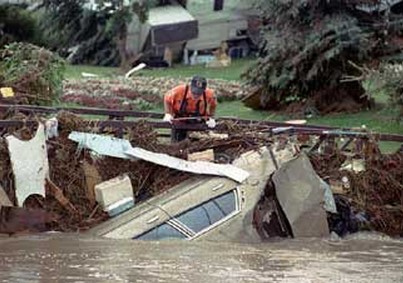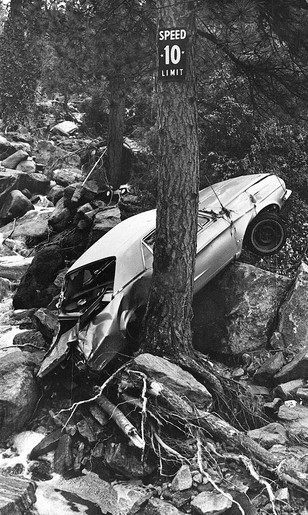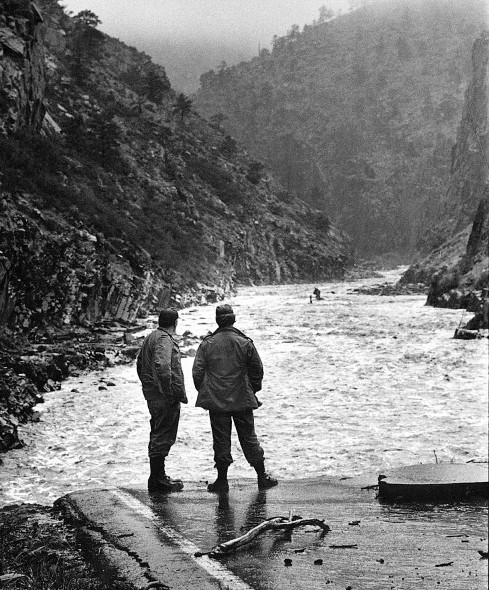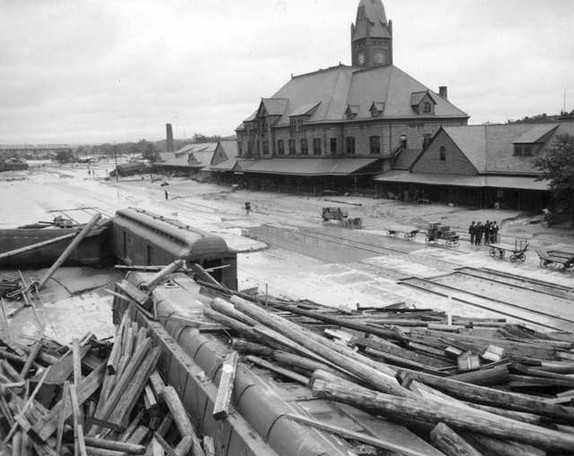In case you needed any more evidence about just how completely full of shit NOAA is.
1997 Spring Creek Flood – Fort Collins
The storm dropped 10 inches of rain on the Quail Hollow area of Fort Collins in less than six hours. It was the most rainfall ever measured in an urban area in Colorado for that amount of time, Doesken said.
1976 Big Thompson River Flood
On July 31, 1976, during the celebration of Colorado’s centennial, the Big Thompson Canyon was the site of a devastating flash flood that swept down the steep and narrow canyon, claiming the lives of 143 people, 5 of whom were never found. This flood was triggered by a nearly stationary thunderstorm near the upper section of the canyon that dumped 300 millimeters (12 inches) of rain in less than 4 hours (more than 3/4 of the average annual rainfall for the area). Little rain fell over the lower section of the canyon, where many of the victims were. Around 9 p.m., a wall of water more than 6 meters (20 ft) high raced down the canyon at about 6 m/s (14 mph), destroying 400 cars, 418 houses and 52 businesses and washing out most of U.S. Route 34.[5] This flood was more than 4 times as strong as any in the 112-year record available in 1976, with a discharge of 1,000 cubic meters per second (35,000 ft³/s).
Big Thompson River – Wikipedia, the free encyclopedia
The Big Thompson flood of 1976 was the deadliest flash flood in Colorado’s recorded history. On July 31, between 12 and 14 inches of rain fell over a four-hour period in the mountains around the resort town of Estes Park. Unusual weather patterns allowed the huge storm system to stall over the area as it dumped its load
1921 Pueblo flood
As the torrential rains fell, the Arkansas River and Fountain Creek quickly began to swell, reaching over 15 feet in some areas before they began to recede. Within two hours from the start of the storm, the entire wholesale district and a greater part of the business district of Pueblo were flooded with water 10 feet deep. The entire Arkansas Valley, from 30 miles west of Pueblo to the Colorado–Kansas state line, was severely impacted. Hundreds of people died, with some death toll estimates as high as 1,500. The flood destroyed almost all of the downtown Pueblo area and decimated the city.
This Month in Climate History: June 3, 1921 Colorado Flooding | National Climatic Data Center (NCDC)
The rainfall intensity of the storms listed above was much greater than this week’s rain.
The NOAA liars who are claiming the current flood is a “biblical 1,000 year flood” should be prosecuted. They are shouting fire in a crowded theatre.







Thanks for being our reporter-on-the-scene.
It sucked spending a beautiful day riding my bicycle. Dirty work, but someone’s got to do it.
Nature always tells you where NOT to build.
The same Rockies have been there for quite awhile, producing plenty of upslope lift for moist air coming in from the east. To say this flood represents anything new is completely insane.
Which is why I support the idea of cutting NOAA’s budget. When you’re that wrong, you don’t deserve to exist. Or rather, you don’t deserve funding.
But NO! We are now being told we don’t understand what 1,000 year flood means. You see it’s all about probabilities of 0.1% based on complex statistics and logarithms and just trust us, it does not matter if this happens on average every 23 years, it’s a 1,000 year flood.
Fort Collins, Pueblo, Boulder and Loveland are all different places.
Suffer a head injury recently?
No. I’m saying that for the purpose of statistics those are different places with different rain measurements. 2 of those places are an hours drive or more from Boulder and Pueblo is more than 2 hours. Imagine saying that a statistic that gives and average chance of weather in Baltimore is wrong because of a measurement in Philadelphia. That’s the equivalent of comparing Pueblo and Boulder for statistical purposes. In fact, Baltimore and Philadelphia are closer.
They are all located along the Front Range and experience similar summer weather patterns.
So do Washington, Baltimore and Philadelphia, but no one would ever cite weather data from one city to the next to contradict average weather statistics.
Your argument is complete bullshit. Alarmists lump all hurricanes, tornadoes, and floods together in a single pot, not just ones which strike Biloxi.
My argument that Boulder, Loveland, Fort Collins, and Pueblo aren’t the same places like Washington, Baltimore and Philadelphia aren’t the same places? Yeah, call me crazy. Now if only the Redskins, Ravens and the Eagles would realize they are all in the same city.
That’s weird. I used live in between DC and Baltimore, and the rain would hit DC first and then hit Baltimore about an hour later. Then Philly.
Your point is idiotic. The storms this week hit everywhere from Colorado Springs to Fort Collins. Do you seriously not have anything intelligent to think about?
So if Philadelphia had a big thunderstorm that dumped alot of rain in a single place you could just make life easier for statistical purposes and count that towards DC’s total?
Rory, please, climate wise, these events are in the same geographical area. The clouds do not care where puny humans build a city. The local weather and geography is consistent. One cannot claim that the climate is growing worse because a severe rain event happened in a location 40 miles from where it happened in the past, and the new location now has a city in that location, therefore the climate is getting worse. Please rethink this, as you are not making any sense.
Let me explain it better then.
The entire use of the term 100 year event and 1000 year event is based on the statistics of a particular area receiving a particular weather event. In fact, when experts use the term, they specifically twist themselves into a pretzel saying they’d rather not use the term, knowing that it will be misunderstood by non-experts, explained incorrectly in the media, and “disproven” by posts like this where the writer disingenuously uses the term by pointing to weather events in cities separated by hours of drive time. (when the Big Thompson Flood happened did a drop of rain even fall in Pueblo?)
The use of the term is a statistical. The entire premise of this post is that that can’t possibly be true that Boulder’s record breaking rain had a .1 or .01 chance of happening in any given year. It then goes on to “prove” its point by pointing to similar events in other cities/canyons. The post is intentionally disingenuous. It does the exact thing it thinks it is criticizing. It’s based on hype and relies on its audience being bad at math and geography.
To paraphrase Seinfeld, this post doesn’t offend me as someone who understands science, it offends me as someone that understands math.
Spare us the bullshit These are regular events here, and the 1,000 year claim was made by someone who doesn’t know what they are talking about. It never reached 100 year flood stage in Boulder
http://www.dailycamera.com/news/boulder/ci_24081189/flood-expert-boulder-experiencing-100-year-flood
Thanks for posting this trip down memory lane… Demonstrating once again that these abnormal events are really… Really just normal…
Alarmists have to blame everything on Global Warming… Highlight every big weather event as some evidence that the planet is changing and we are to blame… A simple search like this demonstrates how uneducated… How truly unscientific these folks really are..
@stevengoddard Again, you are being disingenuous. NOAA’s use of the .01 rain was referring to the amount of rain that fell. USGS’s use of .1 flood was referring to the flood waters in Boulder Creek. You sent me an article about the flood waters.
The reason the flood probability differs from the rain probability is because this storm happened in the Fall and not in the Spring. If this amount of rain fell on top of snow in Nederland and Indian Peaks, that .01 year rain would also be a .01 flood. As it is now, the RAIN was .01, and the FLOOD was .1.
I can’t dumb it down any more. Do you understand now?
I see, it was a 1,000 year flood which was actually a 100 year flood because of some BS theory you have meandering around in your head.
So not only are Fort Collins, Boulder, Loveland and Pueblo intercnageable for statistical purposes but so are the terms “precipitation” and “flood.” Keep up the good sciency writing!
Your repeated attempts to set up straw man arguments are getting rather dull.
Big floods occur along the Front Range about every twenty years. Perhaps not on one particular person’s size 4 hat.
@stevengoddard How is pointing out that the entire premise of the post you wrote being wrong a “straw man argument.” You purposely confuse probabilities of floods with probabilities of rain. You also purposely confuse locations used for those statistics. Boulder received an amount of rain that is very uncommon. It received flooding that is rare but alot less so that the rain it received. The experts who are stating the probabilities of these events are being entirely consistent. You, on the other hand are being entirely and purposely inconsistent. You interchange the terms rain and flood, and you interchange locations and hope that no one would notice. I noticed, and instead of admitting your error you continue to interchange terminology in your responses.
It’s OK to admit when you are wrong. I’ll help. Go ahead and put an update on the post like this:
UPDATE: My criticism of the terms 100 and 1000 year events assumed that both were talking about a flood. They were not, one was referring to flooding in Boulder Creek, the other was referring to rain measurements in Boulder. Additionally, these statistics refer to probabilities of events in specific locations. My post used different locations that do not disprove weather data from specific locations I regret the error.
A quote about a 1000 year “rain” event for a specific location (Boulder) becomes 1000 year “flood” event (even though not a single expert quoted used the term flood in this context) for not just Boulder but all of Colorado’s Front Range. Learn this technique of obfuscation and you too can be a Sciency blogger. It’s perfectly science-ish!
You are completely full of shit. 1976 Big Thompson flood had 14 inches in four hours.
Boulder, 2013 had 14 inches in seven days.
Awesome. How much rain did Boulder get that day? Again, you keep moving locations and confusing rain with flood probabilities. Admit you were wrong, it’s ok. It happens to everyone. (but judging from the rest of your site, it happens to you alot more frequently than others. A feature not a bug?)
There are five major drainages along the northern Front Range
Boulder Creek, Lefthand Creek, St, Vrain River, Big Thompson River, Poudre River.
All drain 500+ square miles, all have flooded several times in the last 30 years. Sadly for you, none have Ex-Lax to help you with your condition.
Listen. You quickly skimmed an article mentioning a 1000 year rain event in Boulder. In your haste to fire off an angry blog post you confused “rain” with “flood” (from last reply you still are) and apparently are still confusing “Boulder” with “five major drainages along the northern Front Range”
By now you probably realize you were in error so you keep trying to move the goalposts in our back and forth. Just admit you were wrong. It’s actually a sign of intelligence. Digging your heels in is the opposite.
ROFLMAO NOAA started the rumor and it is everywhere now.
“By Wednesday night, Boulder County was experiencing a 1,000 year flood — something that has 1/1,000th chance every year of happening, Schumacher said.”
http://www.coloradoan.com/article/20130914/NEWS01/309140020?odyssey=mod%7Cmostcom
You’re doing it again. Keep moving the goalposts. First of all, that’s a reporter paraphrasing (notice no quotes) an assistant (!) professor at CSU, not NOAA.
And there’s a very high probability the reporter is the one that got it wrong. Read this section again: (emphasis mine)
—- Meteorologists along the Front Range watched in disbelief as RAIN GAUGES filled. By Wednesday night, Boulder County was experiencing a 1,000 year FLOOD — something that has 1/1,000th chance every year of happening, Schumacher said. —
Notice, no quotes. It seemlessly co-mingles “rain” and “flood” in the same non exact quote sentence the same way you do, but probably by accident, unlike you.
In conclusion. Not NOAA (but you knew that already) and probably a bad quote.
The cat is out of the bag. How do you put it back in?
This is the exact same thing you did! But you were worse. To recap. You confused 100 year flood with 1000 year rain. You confused Pueblo with Boulder with Fort Collins. And then you confused NOAA with an ASSISTANT Professor at CSU who was probably misquoted.
How can you criticize dumb reporters when you are worse?!
Again. You can correct the record by updating your post. Not doing so says alot more about you than admitting you were wrong.
NOAA got a rumor going of a 1,000 year flood and did nothing to correct it. It is now all over the Internet. How will NOAA fix this?
Show me a direct quote from NOAA calling it a 1000 year flood not a 1000 year rain event. Also, while you’re at it, show me a quote of Obama repeatedly comparing Climate Change Denialists to Holocaust Deniers: http://stevengoddard.wordpress.com/2013/09/16/stupid-conspiracy-theorists-2/
Obama calls skeptics “deniers” all the time. The word denier has always been reserved for Holocaust Deniers.
.Please explain how the government plausible deniability scam works. Something like “Make a loose statement which is designed to get misinterpreted by the press, and then do nothing to sort it out later.”
Still moving those goalposts I see.
What are the odds of someone winning the lottery this week?
You and this site are hilarious. I feel like I’m in the Youtube comments of 9-11 truther videos.
Answer the question, please. So that I can demonstrate how misguided you are.
What are the odds of someone winning the lottery this week?
The media exaggerates constantly. Not just about the weather. Usually about everything. RoryBellows seems to be arguing that they don’t actually exaggerate.